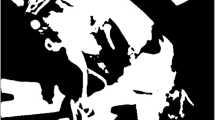Abstract
We develop a neural network architecture to help model the creation of visual temporal object representations. We take visual input to be hard-wired up to and including V1 (as an orientation-filtering system). We then develop architectures for afferents to V2 and thence to V4, both of which are trained by a causal Hebbian law. We use an incremental approach, using sequences of increasingly complex stimuli at an increasing level of the hierarchy. The V2 representations are shown to encode angles, and V4 is found sensitive to shapes embedded in figures. These results are compared to recent experimental data, supporting the incremental training scheme and associated architecture.
Preview
Unable to display preview. Download preview PDF.
Similar content being viewed by others
References
Somers, D.C., Nelson, S.B., Sur, M.: An Emergent Model of Orientation Selectivity in Cat Visual Cortical Simple Cells. J. Neurosci. 15, 5448–5465 (2005)
Troyer, T.W., Krukowski, A.E., Priebe, N.J., Miller, K.D.: Contrast-Invariant Orientation Tuning in Cat Visual Cortex: Thalamocortical Input Tuning and Correlation-Based Intracortical Activity. J. Neurosci. 18, 5908–5927 (1998)
Lauritsen, T.Z., Miller, K.D.: Different Roles for Simple-Cell and Complex-Cell Inhibition. J. Neurosci. 23, 10201–10213 (2003)
Ito, M., Komatsu, H.: Representation of Angles Embedded within Contour Stimuli in Area V2 of Macaque Monkeys. J. Neurosci. 24, 3313–3324 (2004)
Riesenhuber, M., Poggio, T.: Hierarchical models of object recognition in cortex. Nature Neurosci. 2, 1019–1025 (1999)
Riesenhuber, M., Poggio, T.: Models of object recognition. Nature Neurosci. (suppl. 3), 1199–1204 (2000)
Giese, M., Leopold, D.A.: Physiologically inspired neural model for the encoding of face spaces (2004) (preprint)
Fukushima, K.: Neocognitron capable of incremental learning. Neural Networks 17, 37–46 (2004)
Deco, G., Rolls, E.: Object-based visual neglect: a computational hypothesis. Eur. J. Neurosci. 16, 1994–2000 (2002)
Van der Velde, F., de Kamps, M.: From Knowing What to Knowing Where: Modeling Object-based Attention with Feedback Disinhibition of Activation. J. Cog. Neursoci. 13, 479–491 (2001)
Pasupathy, A., Connor, C.E.: Shape Representation in Area V4: Position-Specific Tuning for Boundary Configuration. J. Neurophysiol. 86, 2505–2519 (2001)
Hegde, J., Van Essen, D.C.: Selection for Complex Shapes in Primate Visual Area V2. J. Neurosci. 20(RC61), 1–6 (2000)
Felleman, D.J., van Essen, D.C.: Distributed hierarchical processing in the primate cerebral cortex. Cerebral Cortex 1, 1–47 (1991)
Bi, G.-Q., Poo, M.-M.: Synaptic modifications in cultured hippocampal neurons: dependence on spike timing, synaptic strength, and postsynaptic cell type. J. Neurosci. 18, 10464–10472 (1998)
Dan, Y., Poo, M.-M.: Spike Timing-Dependent Plasticity of Neural Circuits. Neuron 44, 23–30 (2004)
Taylor, J., Hartley, M., Taylor, N.: Attention as Sigma-Pi Controlled Ach-Based Feedback. In: IJCNN 2005 (2005) (submitted)
Author information
Authors and Affiliations
Editor information
Editors and Affiliations
Rights and permissions
Copyright information
© 2005 Springer-Verlag Berlin Heidelberg
About this paper
Cite this paper
Taylor, N.R., Hartley, M., Taylor, J.G. (2005). Coding of Objects in Low-Level Visual Cortical Areas. In: Duch, W., Kacprzyk, J., Oja, E., Zadrożny, S. (eds) Artificial Neural Networks: Biological Inspirations – ICANN 2005. ICANN 2005. Lecture Notes in Computer Science, vol 3696. Springer, Berlin, Heidelberg. https://doi.org/10.1007/11550822_10
Download citation
DOI: https://doi.org/10.1007/11550822_10
Publisher Name: Springer, Berlin, Heidelberg
Print ISBN: 978-3-540-28752-0
Online ISBN: 978-3-540-28754-4
eBook Packages: Computer ScienceComputer Science (R0)




